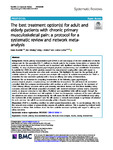The best treatment option(s) for adult and elderly patients with chronic primary musculoskeletal pain: a protocol for a systematic review and network meta-analysis
| dc.contributor.author | Koechlin, H | |
| dc.contributor.author | Whalley, Ben | |
| dc.contributor.author | Welton, NJ | |
| dc.contributor.author | Locher, C | |
| dc.date.accessioned | 2021-10-13T12:53:28Z | |
| dc.date.issued | 2019-11-09 | |
| dc.identifier.issn | 2046-4053 | |
| dc.identifier.issn | 2046-4053 | |
| dc.identifier.other | 269 | |
| dc.identifier.uri | http://hdl.handle.net/10026.1/18049 | |
| dc.description.abstract |
<jats:title>Abstract</jats:title><jats:sec><jats:title>Background</jats:title><jats:p>Chronic primary musculoskeletal pain (CPMP) is one subcategory of the new classification of chronic primary pain for the upcoming ICD-11, defined as chronic pain in the muscles, bones, joints, or tendons that persists or recurs for more than 3 months and is associated with significant emotional distress or functional disability. An array of pharmacological, psychological, physical, complementary, and rehabilitative interventions is available for CPMP, for which previous research has demonstrated varying effect sizes with regard to effectiveness in pain reduction and other main outcomes. This highlights the need for the synthesis of all available evidence. The proposed network meta-analysis will compare all available interventions for CPMP to determine the best treatment option(s) with a focus on efficacy and safety of interventions.</jats:p></jats:sec><jats:sec><jats:title>Methods</jats:title><jats:p>We are interested in comparing interventions of the following types: psychological, pharmacological, physical, complementary, and rehabilitative interventions. We will include all randomized controlled trials that compare one intervention with another, or with a control group, in the treatment of CPMP. Primary efficacy outcomes will be pain intensity, emotional distress, and functional disability. Safety outcomes extracted will include proportion of patients with treatment-emergent adverse events, unwanted events, or drop-out rates due to side effects. Published and unpublished trials will be sought through the search of all relevant databases and trial registries. At least two independent reviewers of the team will select the references and extract data independently. We will assess the risk of bias of each individual study using the Cochrane risk of bias assessment tool. We will conduct a network meta-analysis to synthesize all evidence for each outcome. We will fit our model primarily within a Bayesian framework.</jats:p></jats:sec><jats:sec><jats:title>Discussion</jats:title><jats:p>CPMP is a disabling condition for which several interventions exist. To our knowledge, this is the first network meta-analysis to systematically compare all available evidence. This is required by national health institutions to inform their decisions about the best available treatment option(s) with regard to efficacy and safety outcomes.</jats:p></jats:sec><jats:sec><jats:title>Systematic review registration</jats:title><jats:p>PROSPERO<jats:ext-link xmlns:xlink="http://www.w3.org/1999/xlink" ext-link-type="uri" xlink:href="https://www.crd.york.ac.uk/prospero/#recordDetails">CRD42018096114</jats:ext-link></jats:p></jats:sec> | |
| dc.format.extent | 269- | |
| dc.format.medium | Electronic | |
| dc.language | en | |
| dc.language.iso | en | |
| dc.publisher | Springer Science and Business Media LLC | |
| dc.subject | Chronic primary musculoskeletal pain | |
| dc.subject | Network meta-analysis | |
| dc.subject | Adults | |
| dc.subject | Elderly | |
| dc.subject | Intervention | |
| dc.title | The best treatment option(s) for adult and elderly patients with chronic primary musculoskeletal pain: a protocol for a systematic review and network meta-analysis | |
| dc.type | journal-article | |
| dc.type | Journal Article | |
| dc.type | Research Support, Non-U.S. Gov't | |
| plymouth.author-url | https://www.webofscience.com/api/gateway?GWVersion=2&SrcApp=PARTNER_APP&SrcAuth=LinksAMR&KeyUT=WOS:000495586000001&DestLinkType=FullRecord&DestApp=ALL_WOS&UsrCustomerID=11bb513d99f797142bcfeffcc58ea008 | |
| plymouth.issue | 1 | |
| plymouth.volume | 8 | |
| plymouth.publication-status | Published | |
| plymouth.journal | Systematic Reviews | |
| dc.identifier.doi | 10.1186/s13643-019-1174-6 | |
| plymouth.organisational-group | /Plymouth | |
| plymouth.organisational-group | /Plymouth/Faculty of Health | |
| plymouth.organisational-group | /Plymouth/Faculty of Health/School of Psychology | |
| plymouth.organisational-group | /Plymouth/REF 2021 Researchers by UoA | |
| plymouth.organisational-group | /Plymouth/REF 2021 Researchers by UoA/UoA04 Psychology, Psychiatry and Neuroscience | |
| plymouth.organisational-group | /Plymouth/Research Groups | |
| plymouth.organisational-group | /Plymouth/Research Groups/Centre for Brain, Cognition and Behaviour (CBCB) | |
| plymouth.organisational-group | /Plymouth/Research Groups/Centre for Brain, Cognition and Behaviour (CBCB)/Behaviour | |
| plymouth.organisational-group | /Plymouth/Research Groups/Plymouth Institute of Health and Care Research (PIHR) | |
| plymouth.organisational-group | /Plymouth/Users by role | |
| plymouth.organisational-group | /Plymouth/Users by role/Academics | |
| dc.publisher.place | England | |
| dcterms.dateAccepted | 2019-09-27 | |
| dc.rights.embargodate | 2021-10-14 | |
| dc.identifier.eissn | 2046-4053 | |
| dc.rights.embargoperiod | Not known | |
| rioxxterms.versionofrecord | 10.1186/s13643-019-1174-6 | |
| rioxxterms.licenseref.uri | http://www.rioxx.net/licenses/all-rights-reserved | |
| rioxxterms.licenseref.startdate | 2019-11-09 | |
| rioxxterms.type | Journal Article/Review |


